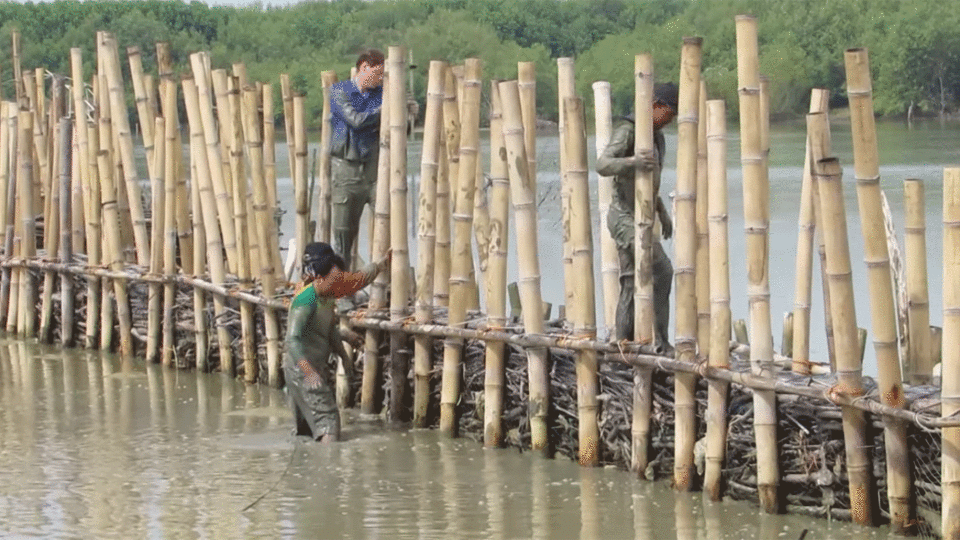“She must be really good at writing” the villagers are whispering behind my back. I am sitting on a small bamboo platform, used for fishing, with my notebook on my lap to write down the sedimentation rates behind our permeable dams. The four guys of the team are wrestling through the mud and shout the values to me: “5 centimetres of sedimentation behind our dam”, “45 centimetres here”, “erosion in the control plot”.
The permeable dams were built to attenuate the waves and trap the sediment along the Demak coastline in Northern Java. By doing this we are hoping to reverse the massive erosion along this coastline and grow back a mangrove greenbelt.
45 centimetres of sedimentation!
Most construction was done last October and November, and now we are already finding 45 centimetres of sedimentation. Behind one of the dams the mangrove seedlings are already emerging everywhere. If the dam structure stays in place there can be a small forest in that area within a year or two. The mangrove forest should then take over the role of the dams and attenuate the waves and keep the sediment in place. These findings bring hope that our approach can potentially work.
Room for improvement
However, there are also less hopeful tidings. Some of our dams are severely damaged during the storms that are accompanying the monsoon. The most common problem is the complete disappearance of the brushwood in between the bamboo poles and this seems mainly caused by wrong construction and lack of maintenance. On the other hand, it is obvious that the current design easily fails so we should also challenge ourselves to come up with new designs that are more robust.
Also, witnessing the force of the waves on a stormy day makes me realize that forces on the dams may have been underestimated. Waves are banging continuously on the dams.
There is room for improvement but the sedimentation behind the dams that are still standing is large and the colonization of mangroves this early in the project is a pleasant surprise.
Stop mangrove cutting
Stepping out of the car one morning, I witness mangrove clearing and cutting to bring back aquaculture ponds in the mangrove area we have been restoring last years; a big disappointment. I point it out to the community facilitators and discuss that the community themselves have signed a treaty to transform these restored forests to protected area.
Later that day during a session with the deputy village chief the field facilitators tell him about the conversion of new mangrove to ponds. The dynamics in the group are a pleasure to observe. Each facilitator has his own role and they complement each other nicely. They try to get the deputy village chief to say that he rejects this mangrove cutting, but instead he promises to bring it up with the village head. One of the most important aspects of the project is raising awareness in the community that with these actions they shoot themselves in the foot as restoration of the mangroves is to benefit their well-being. Go field facilitators!
Complex problems require complex solutions
This week in the field we also visited the rapidly eroding coast in the south, bordering the city of Semarang. For this coast our permeable structures will not be more than plasters on a person that is heavily bleeding.
Problems of such large scale cannot be solved by easy and small scale solutions. Large-scale erosion, subsidence and river damming need interdisciplinary solutions between different governmental entities with substantial amounts of investment.
Large-scale problems also need the courage the face difficult solutions and discussions, such as what should happen with people that live in these areas? How will we deal with industries that caused these problems by extraction of ground water? Unpopular messages, but that should not be a reason to not deal with it. For our project this will be picked up in our dialogue with the government.
We are only one year ahead with our project and challenges are numerous. We need interdisciplinary system understanding to solve erosion problems, we need a good local basis to involve the community and we need to translate to politics and regulations to consolidate our approach beyond project lifetime and beyond the coastline of Demak and we can only take it step by step.
About the project
Partners under this Building with Nature initiative aim to enhance coastal resilience for 70,000 vulnerability people in Central Java by avoiding further coastal flooding and erosion and by providing them with a long term perspective for sustainable economic development. We do this through a unique integration of mangrove restoration, small scale engineering and sustainable land use (Building with Nature). The partners further aim for replication and scaling up of the Building with Mangroves approach to other rural and urban areas in Indonesia and other vulnerable muddy coastlines in the world, including through capacity building, knowledge exchange and embedding in policies and planning.
Wetlands International coordinates the initiative in partnership with the Ministry of Marine Affairs and Fisheries (MMAF), Ministry of Public Work and Human Settlement (PU), the Ecoshape Consortium, consultancy agency Witteveen + Bos, knowledge institutes Deltares, Wageningen University & Research Centre, IMARES and UNESCO-IHE, with support from the Diponegoro University, and local communities.
Bregje van Wesenbeeck, Deltares, reporting from Demak, Indonesia


Leave a comment